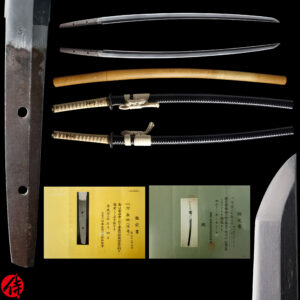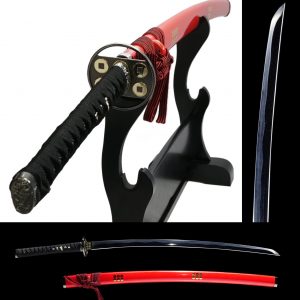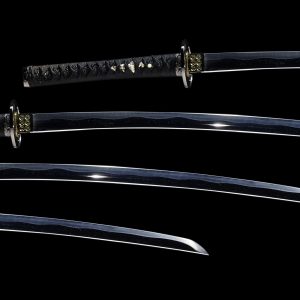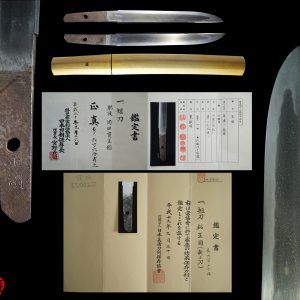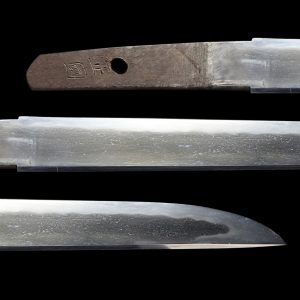Antique Japanese Sword Katana signed by Tadayuki with NBTHK Hozon Certificate
【Description】
This blade was forged by Sesshu Ju Fujiwara Tadayuki (摂州住藤原忠行), whose birthname is Tarouemon (太郎右衛門), during the early Edo Period (the late 17th century). Sesshu is another name of Settsu province (today’s Osaka) and Sesshu Ju means that he resided in this area when he forged this blade. The maker’s name Tadayuki lasted several generations during the Edo period. Based on the signature, we believe the first-gen Tadayuki forged it.
The first-gen Tadayuki was the younger brother of Awataguchi Omi no Kami Tadatsuna (粟田口近江守忠綱), one of the most famous swordsmiths in Osaka in the early Edo period. It is said that the first-gen Tadayuki was an apprentice of Tadatsuna, so was the second-gen. And the first-gen often did Daimei for Tadatsuna while the second-gen helped them forged great swords. Daimei is a regular act where an apprentice or a child of the swordsmith signed his master’s name with his master’s permission, being involved in a sword-forging.
After the first-gen Tadayuki was given the honorable title Settsu no Kami (摂津守), he began to sign the name of Settsu no Kami Tachibana Tadayuki (摂津守橘忠行), Settsu no Kami Fujiwara Tadayuki (摂津守藤原忠行) and other name on his blade. Also, it is said that among the several-gen Tadayuki, the first-gen was most appreciated for his high sword-forging skill and the sharpness of his blades.
The blades forged by Tadayuki are categorized as Osaka Shinto. Shinto is Japanese Sword terminology that refers to the swords forged during 1596-1781. The blades made in Osaka area during this period are called Osaka Shinto. There are many famous swordsmiths in this Osaka Shinto era. After Hideyoshi Toyotomi built Osaka castle, Osaka city flourished as a castle town and became the business center. Many swordsmiths moved to Osaka to look for better opportunities. They not only forged swords for those Samurai who lived in Osaka but also for feudal lords nationwide. Ikanshi Tadatsuna (Awataguchi Omi no Kami Tadatsuna), Inoue Shinkai, and Tsuda Sukehiro are the most famous ones among those many swordsmiths.
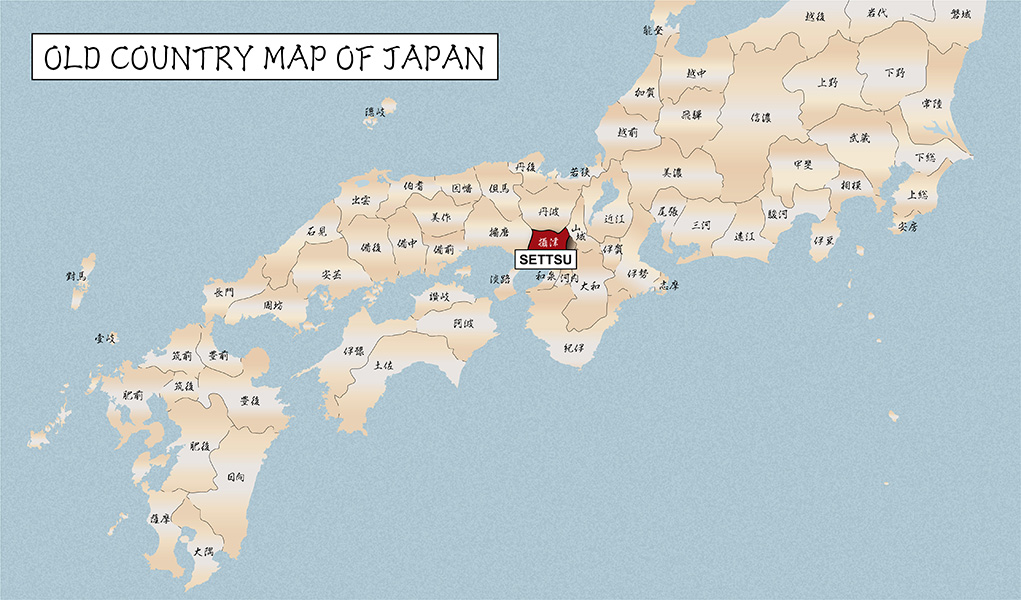
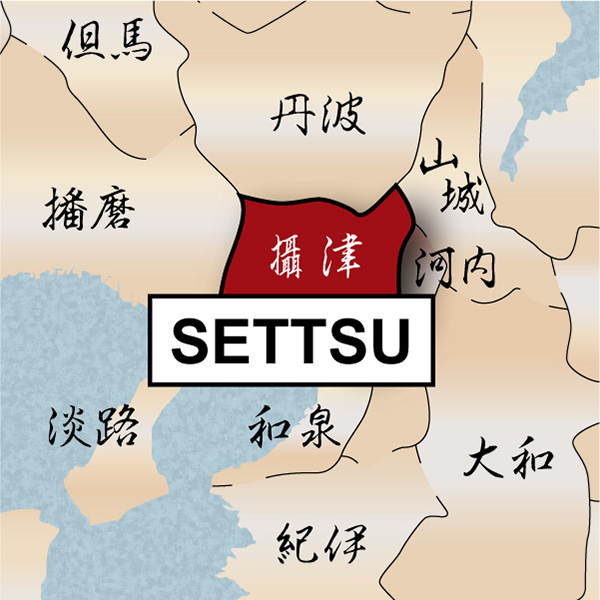
One of the most notable characteristics of Osaka Shinto is its beauty in Jigane. Jigane is a visible steel surface pattern created by folding and hammering during the forging process), which made it possible by the location of Osaka. Osaka had close access to the Tamahagane (special carbon steel to make Japanese swords) production sites. The swordsmiths residing in Osaka were able to get high-quality carbon steel from these sites.
This blade is appraised as a Hozon Touken (保存刀剣) issued by NBTHK (Nihon Bijutsu Touken Hozon Kyokai: 日本美術刀剣保存協会). This authentication paper was only given to authentic Japanese swords, well preserved and high quality with artistic value.
【 Blade】
Cutting Edge Length(Nagasa): 75.1 cm(29.5 inches)
Curvature(Sori): 1.4 cm(0.55 inches)

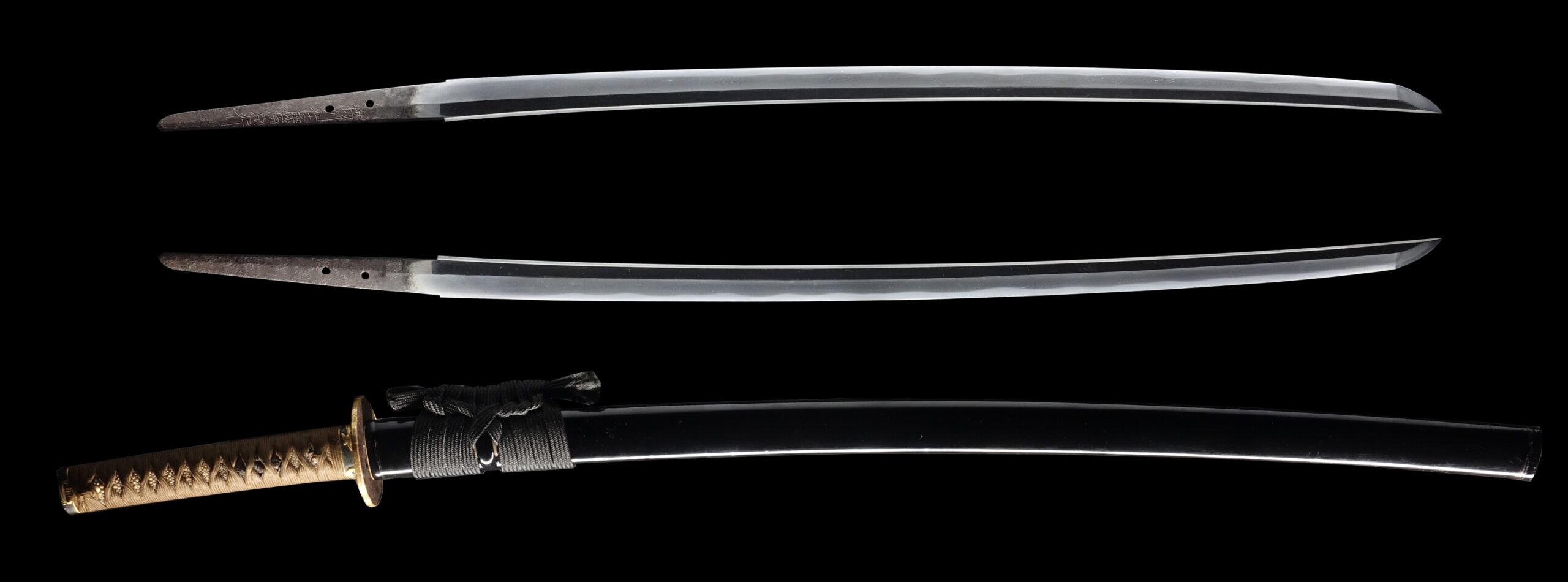
Hamon:
The crystalline structure which forms along the cutting edge of a blade as a result of the hardening process.
Jimon (Jihada):
Visible steel surface pattern created by folding and hammering during forging process.

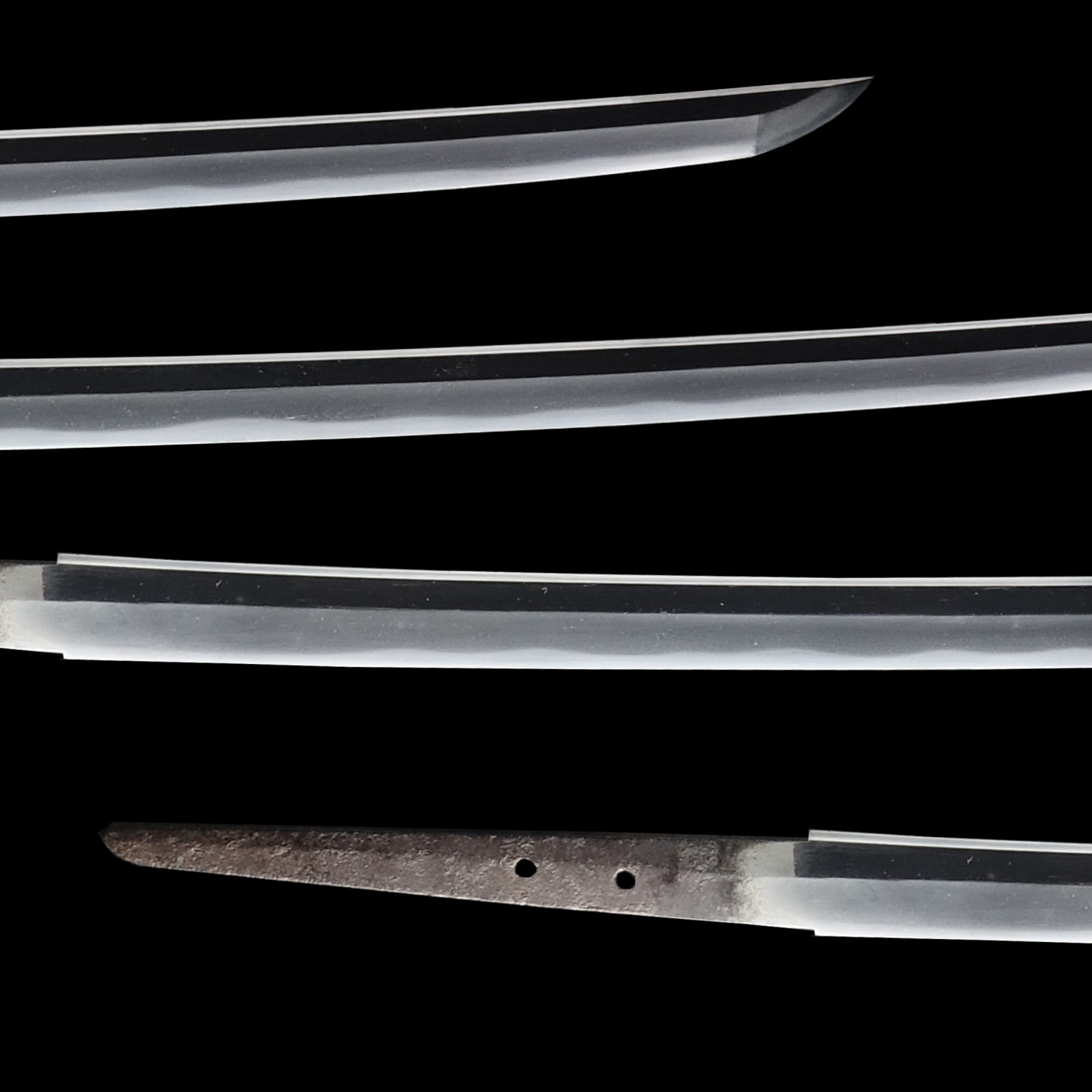
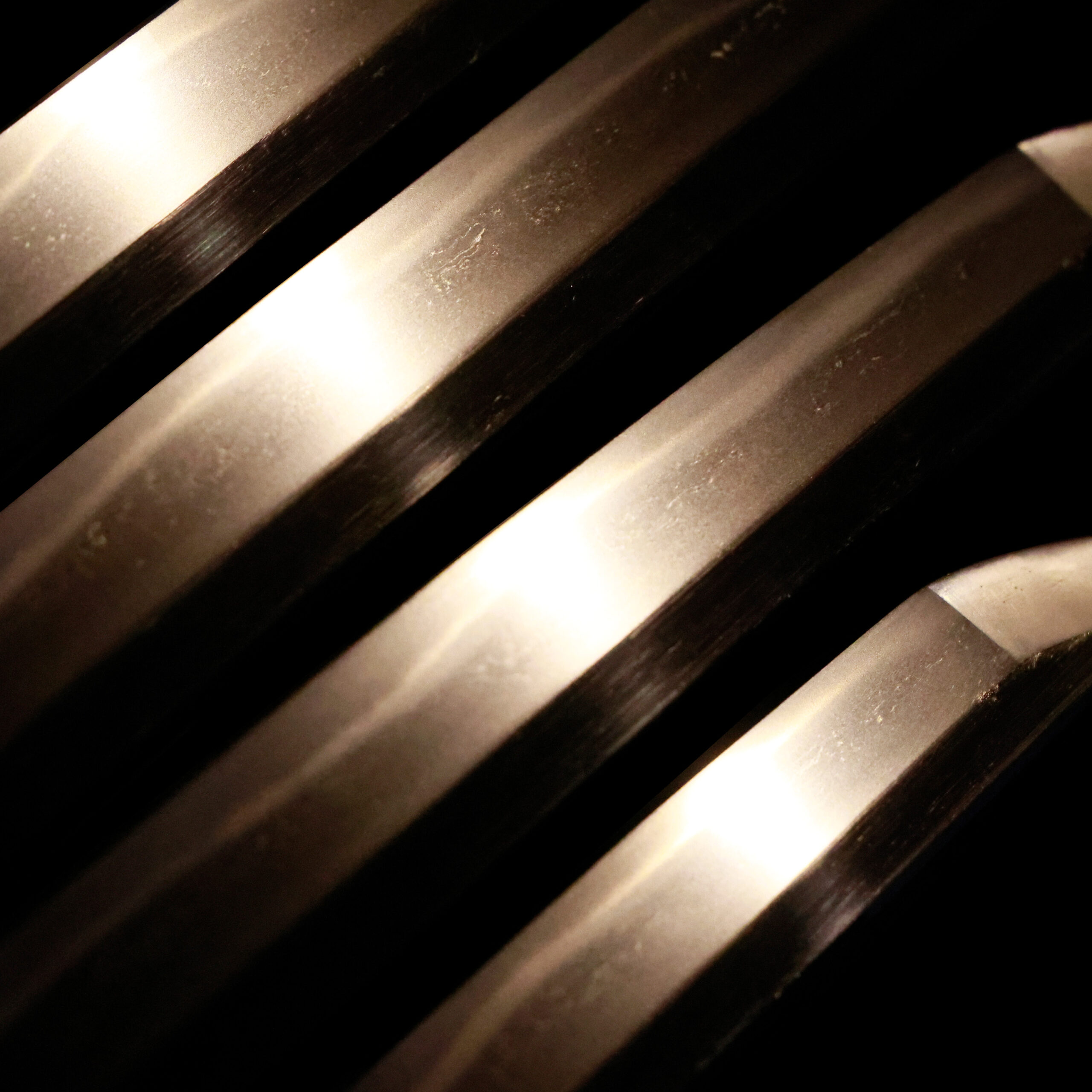



Kissaki: Kissaki is the tip of the Japanese sword.

Nakago:Nakago is the tang of the Japanese sword.
Japanese swordsmiths left the black rust on the tang because it prevents red rust while the tang is in its handle. And the discoloration of the tang was created over time, and it is a great indicator for a Japanese sword specialist to estimate when the sword was forged.

Koshirae:Koshirae is the mounting of the Japanese sword. There are several parts that consist of Koshirae such as Saya (Scabbard), Tsuka (Handle), Tsuba (Handguard).

Fuchi-Kashira:A pair of matching sword fittings that cover the upper and bottom parts of its sword hilt.
The Fuchi-Kashira features an intricate gold inlay (kin-zōgan, 金象嵌) design of a Fenghuang (鳳凰, also known as Houou in Japanese), one of the four mythical creatures collectively known as the “Shirei” (四霊), along with the Kirin (麒麟, Qilin), Kame (亀, Turtle), and Ryū (龍, Dragon). The Houou is a divine beast that resembles a blend between a chicken and a peacock. In ancient China, it was regarded as an auspicious omen, believed to appear only during the reign of a virtuous and wise emperor. In Japan as well, the Houou is admired for its elegant form and is often used in traditional art and decoration.
The tsuba (sword guard) also depicts a beautifully rendered Houou soaring among the clouds, creating a strong sense of aesthetic and symbolic unity across the sword fittings.
The background of this piece is crafted using the Nanako-ji (魚子地) technique, a traditional metalworking method commonly used in sword fittings and other decorative metal objects. The term “Nanako” (魚子) literally means “fish roe,” while “ji” (地) refers to the surface or background. This technique involves meticulously hammering the metal surface with a specialized punch to create a dense pattern of tiny, uniform raised dots, resembling fish eggs. This finely textured background enhances the overall aesthetic of the piece while providing a striking contrast to decorative elements such as inlays and carvings, highlighting the exceptional craftsmanship of Japanese artisans.

Tsuka and Menuki:Tsuka is the handle of the Japanese sword and Menuki is its decoration.
The theme of this menuki is the deer (鹿, shika), an animal that has been revered throughout Japan for centuries. Deer are considered sacred creatures and have long been regarded as messengers of the gods in Shinto tradition. At ancient shrines such as Kasuga Taisha in Nara and Kashima Jingu in Ibaraki, deer are still protected and treated with deep respect as “shinroku” (神鹿)—divine deer.
In the Muromachi period (1336–1573), killing a sacred deer was considered a serious crime punishable by death. Even today, harming these protected animals is subject to penalties under local regulations in certain areas, reflecting how deer continue to be cherished and respected in modern Japan.
*Please keep in mind that there is some peeling on the ray skin (鮫皮, Samegawa) of the handle.


Tsuba and Habaki:Tsuba is the handguard for the Japanese Sword and Habaki is the equipment to make the blade not touch its scabbard inside. It prevents the blade from getting rusty and chipped.
This blade’s Habaki is decorated with the Kikusui-mon (菊水紋), a crest that depicts chrysanthemum flowers floating on running water. The Kikusui-mon has long been regarded as a symbol of longevity and good fortune, originating from an ancient Chinese legend. According to the tale, one could prolong their life by drinking water that flowed through a field of chrysanthemums. Because of this association, the design came to be treated as an auspicious motif.
It is believed that the use of the Kikusui pattern began during the Kamakura period (1185–1333). The design often features a beautiful combination of chrysanthemum blossoms and flowing water, embodying both elegance and symbolic meaning.

Saya: Saya is the scabbard for the Japanese sword.
This scabbard is covered with black lacquer. Due to its high waterproof effect, lacquer has been used since ancient times in Asia. The blade of a Japanese sword is made of iron, and moisture is the greatest enemy of iron. For the purpose of carrying the blade without degrading it, people devised a method of coating the scabbard with lacquer. To prevent not only moisture but also rain and snow from penetrating the inside of the scabbard, it was necessary to apply multiple layers of lacquer. The Nushi (塗師, lacquerers) was born precisely because advanced techniques were required to handle the complicated processes.

Authentication Paper: NBTHK Hozon Certificate for the blade (No.341942)
NBTHK, also known as Nihon Bijutsu Touken Hozon Kyokai (the Society for the Preservation of the Japan Art Sword), is one of the oldest Japanese sword appraising organizations in modern-day Japan. They authenticated the blade on July 21st in the 7th year of Heisei (1995). They appraised it as Hozon Touken, the blade worth preserving for Japanese society. The purchaser will receive this original certificate as well. We can also translate what is written into English and make a PDF file for your record if you request.

Registration Number: Miyazaki 32023
The Board of Education in Miyazaki prefecture issued a registration paper for this sword. It is called Jyu Hou Token Rui Tourokusho (銃砲刀剣類登録証). Bunkacho (The Agency for Cultural Affairs) acknowledges a Japanese sword with this paper as a work of art.
The sword needs to be traditionally hand-forged and made of Tamahagane carbon steel to be registered in the system. With this paper, its owner in Japan can legally own an authentic Japanese sword. Based on this registration number, we will apply for its export permit.
This paper will need to be returned to the board of education when the sword is being shipped abroad, but you can receive a copy of it. An English translation of this registration paper is available on request.
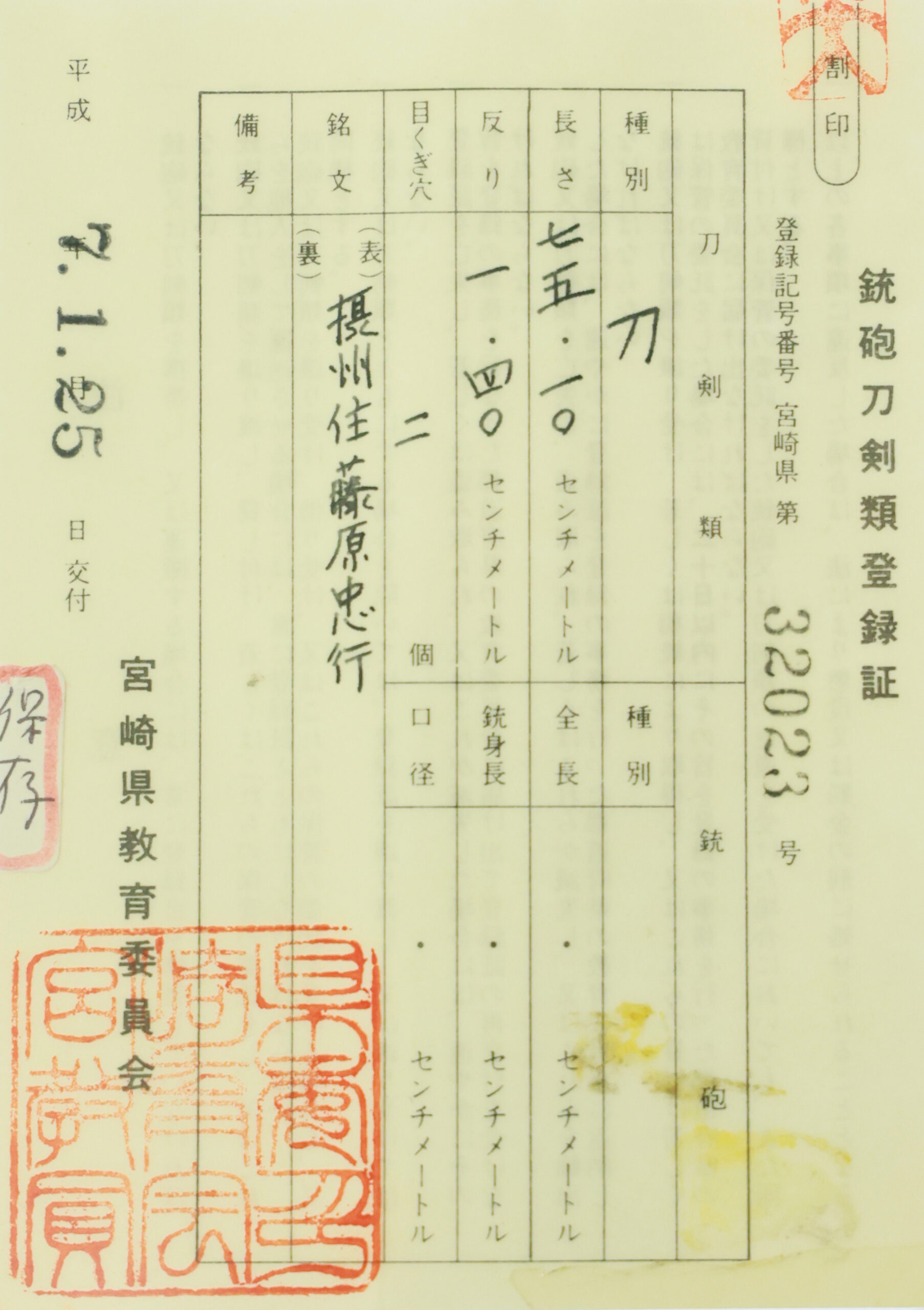
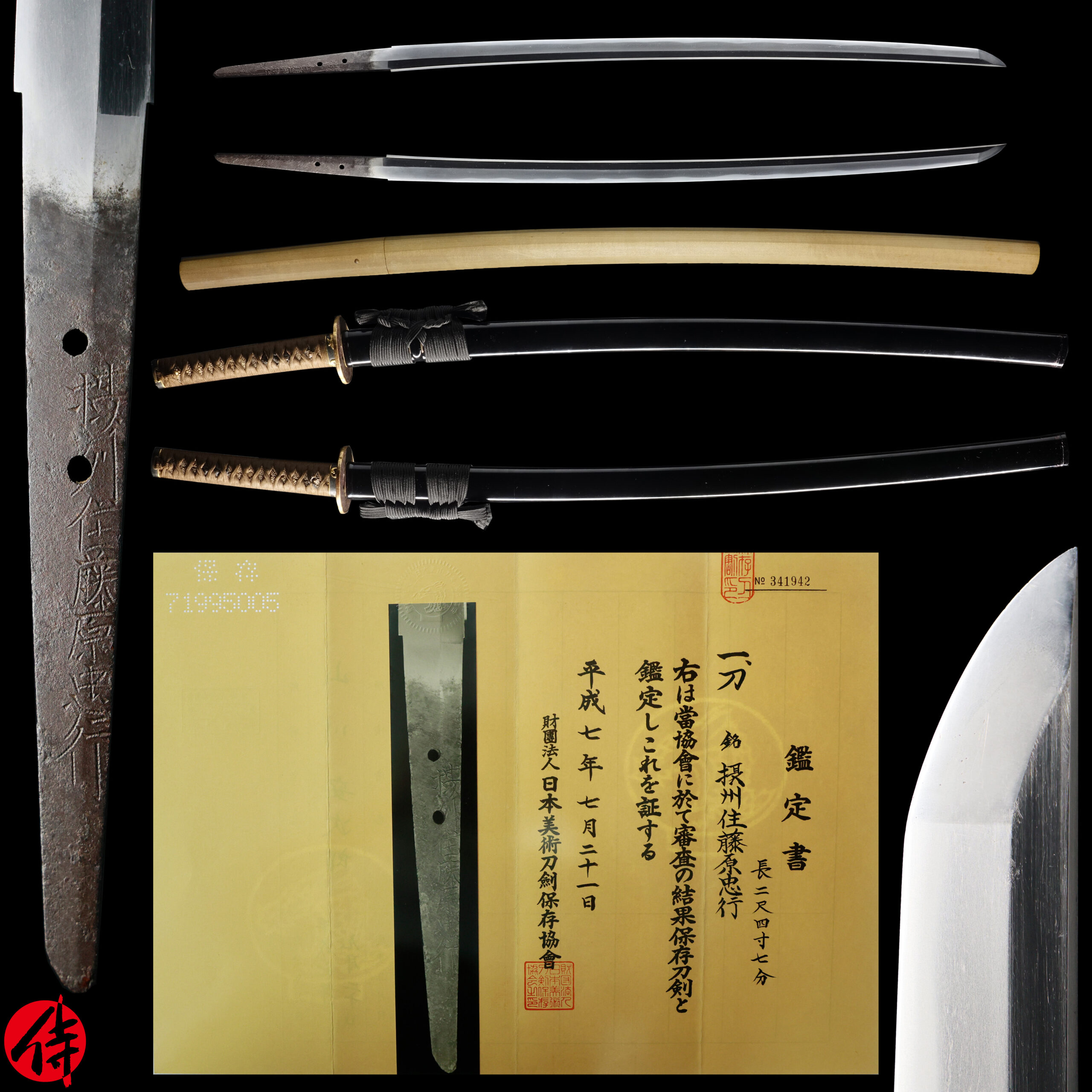
—————————————————————–
【About us】
Samurai Museum is located in Tokyo, Japan, exhibiting antique artifacts related to the Samurai history. Samurai Museum Shop is the place for those who are interested in Japanese culture and craftsmanship. We deal with antique Samurai swords/armor, traditional crafts made in Japan and so on.
【Japanese Sword& Export Process】
The Japanese swords we deal with are hand-forged edged swords made in Japan. It was made from the traditional carbon steel called TAMAHAGANE(玉鋼). Samurai Museum is familiar with the proper legal procedure for an antique/ authentic Japanese sword to be exported from Japan. We have sent more than 1000 Japanese swords for the past few years (~2025) to amazing owners who appreciate its historical value.
Each Japanese sword is registered under the Agency for Cultural Affairs and the Board of Education in Japan. They issue a registration paper for each Japanese sword for its owner in Japan to legally possess it. The Japanese sword with its registration paper means it was traditionally hand-forged in Japan.
To legally export the sword from Japan to other countries, we will have to apply for its permit to the Agency for Cultural Affairs(Bunkacho) and return the original registration paper to the Board of Education. It normally takes around 2-4 weeks to receive this permit after submitting required documents. And we would like you to expect at least 1-1.5 months for your order to arrive at your given address after you ordered. For more detailed info, please click here.
It is allowed for residents in Japan to own authentic Japanese swords without a special license as long as they come with registration papers. Please feel free to contact us if you are a resident of Japan, whether temporarily or permanently. We will also assist you when you leave Japan and need to obtain the export permit.
【Payment Method】
We accept payment through Stripe (Credit card), PayPal, Apple Pay or ChromePay, all of which are secure payment methods. Also, you don’t need to make an account on Stripe for the checkout. If you prefer other payment method, please contact us. After confirming your payment, we will apply for an export permit. You may either pay in JPY, USD, AUD, CAD,EUR CHF or GBP. The price is set in Japanese Yen. Prices in other currencies are automatically calculated based on the latest exchange rate.

* If the amount is above 1 million JPY, Stripe or wire transfer will be the only options for payment.
【Shipping】
We have shipped authentic Japanese swords to the USA, Canada, Mexico, Germany , Belgium, France, Finland, UK Hong Kong, Australia. If you don’t live in these countries and like to order, please contact us first before making a purchase. We offer Free International Shipping as long as we can send antique Japanese swords by EMS.
We normally ship by EMS(Express Mail Service) provided by Japan Post. We will send you a tracking number for your order as soon as we hand it to the post office. We will put 100 % insurance on the shipping document without any extra charge. Based on the total amount, there might be a duty tax or other fee for you to pay, depending on the countries. We use package cushioning to protect the item and put it in a PVC pipe, which is one of the most secure packages because of its durability.
It will normally takes 5-14 days for the item to arrive at your given address after we dispatch it. Time of delivery is estimated as accurately as possible by the carrier but does not take into account any delays beyond our control such as by inclement weather, post office holiday seasons.
* If you live in Australia and like to purchase an authentic Japanese sword, please click here to know the detail.
* If you live in the UK and like to purchase an authentic Japanese sword, please contact us first and click here to know the detail.

【Review】
Here is one of the reviews we received from a customer who purchased an authentic Japanese sword from us. For more reviews, please click here.
“My experience overall with the whole process was wonderful. I had many questions about the history and process to purchase these treasures. All my questions were answered very timely and complete. The staff is very knowledgeable and very well versed if any questions do arise.”
【How to make sure the condition】
Please keep in mind that what you are going to purchase is an antique item. We uploaded high resolution photos for you to check its condition thoroughly. If you like to see more photos with different angles, please feel free to contact us. We will be happy to send them to you so that you can make informed decision. It is essential for us to know that you are happy with your choice of a sword. and we are prepared to use the best of our ability to serve you.
【How To Contact Us】
Please contact us through email, Facebook Messenger or Live Chat if you have any questions. You can find each icon on the right side of the website. Please click one of them to reach us. We will reply to you within 1-2 business days.
【The Art of Nihonto (Japanese Sword)】
Samurai’s history is a profound, eloquent legacy of ancient Japanese warriors in which millions of people worldwide are being fascinated. If you like to find out the art of Nihonto, please click here.
【A Guide to Japanese Sword Maintenance】
After acquiring an genuine Japanese sword, it is also important to know how to take good care of it. Here is the special video for you. Mr. Paul Martin, Japanese sword expert, shows you how to give proper maintenance to your sword. By mastering how to clean the Japanese sword, its aesthetic beauty will last forever.
When you purchase a Japanese sword from us, you can get a Free Japanese sword maintenance kit. It comes with four tools(Choji Oil, Uchiko Whetstone Powder, Peg remover, Oil Applicator). By watching the video instruction above , you can enjoy learning how to maintain your Japanese sword while appreciating it. If you have any difficulty assembling the sword or cleaning the blade, you can feel free to contact us.
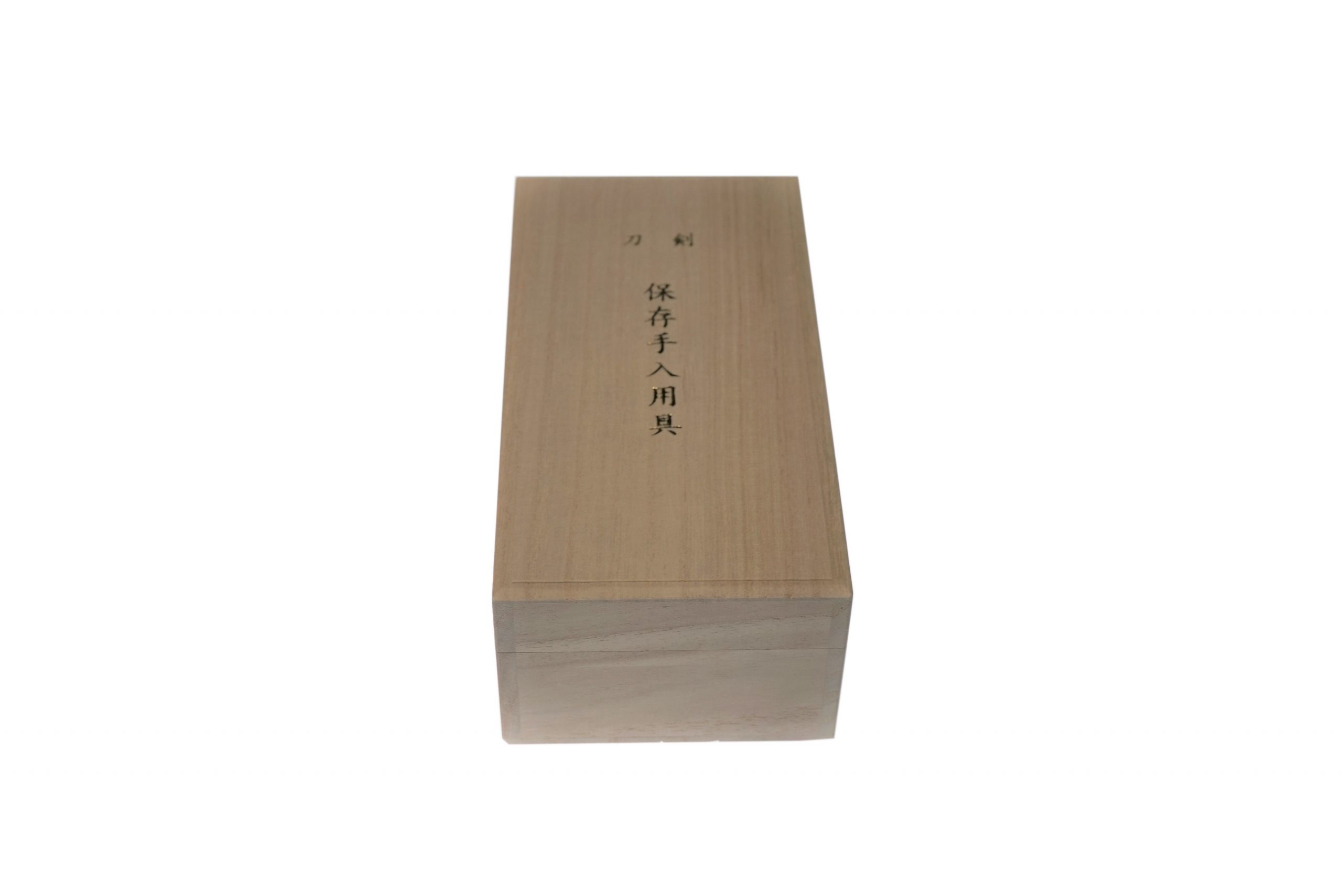
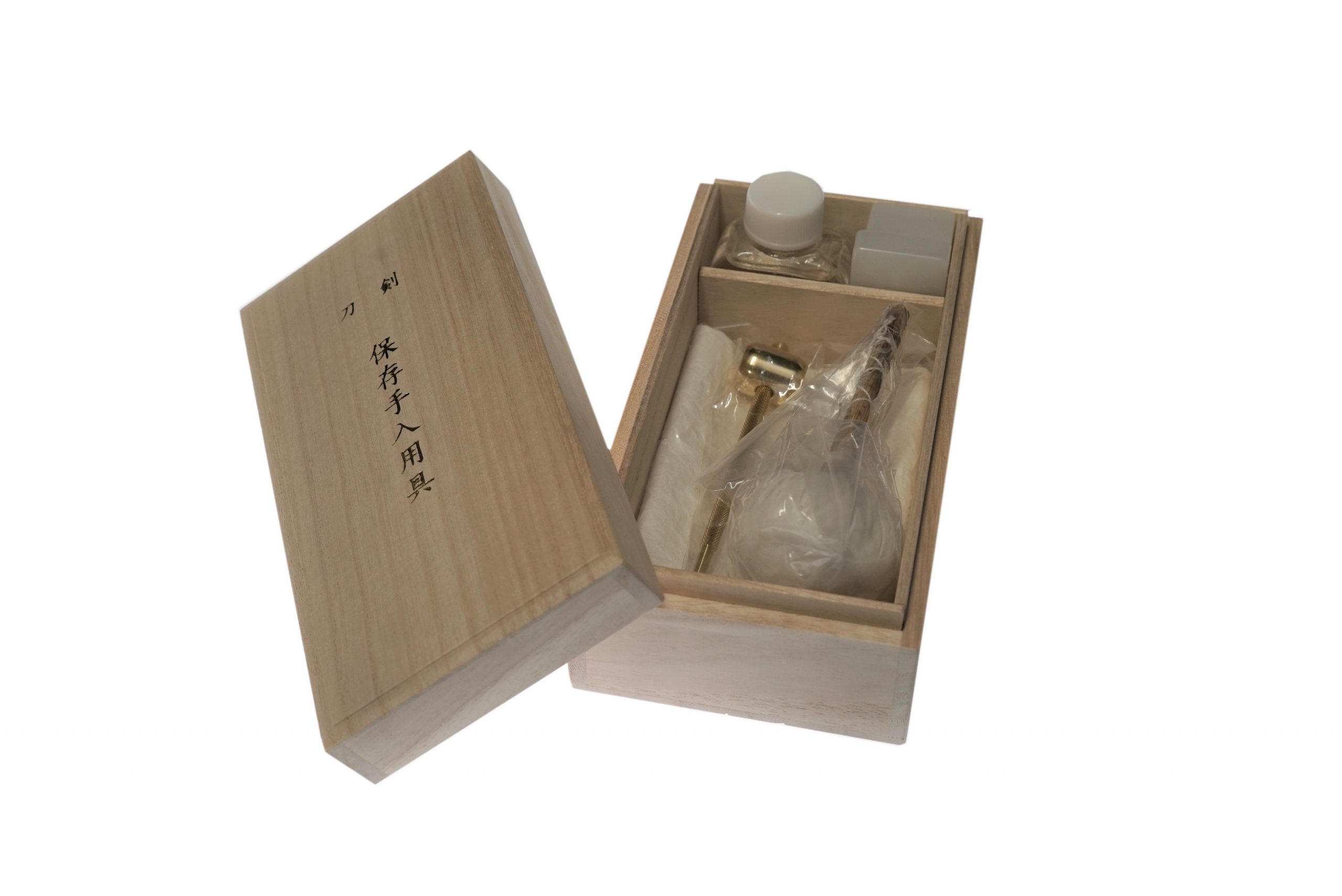
MORE ANTIQUE JAPANESE SWORD FOR SALE
SWORDS WITHOUT CERTIFICATES FOR SALE
LEARN JAPANESE SWORD TERMINOLOGY
Thank you for reading all the information on the page. If you have any difficulty choosing the right Japanese sword for you, we will be more than happy to help you find the one that speaks to you the most. Please feel free to contact us.






